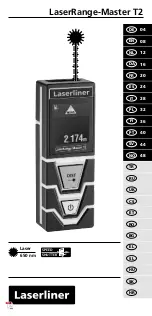
isoNAV685-D_D00215_02_M_XXEN/04.2017
29
Settings
10. Settings
10.1 Settings in the device menu
The settings of the ISOMETER® are explained in the order of the device menu.
10.1
(1.0)Alarm settings
The limit values for the insulation resistances of alarm 1 and alarm 2 can be specified in
the alarm settings menu and can be adapted to the user profile of the ISOMETER®.
A device password is required for entering the settings. You can adjust the following
functions:
10.1
(1.1) Insulation alarm
In the Insulation alarm menu, the ISOMETER® limit values for alarm 1 and alarm 2 can be
set.
The activation or deactivation of the alarm for
R
an
is illustrated in the following graph:
An alarm will become inactive as soon as +25 % +0.5 kΩ of the set operating value is
exceeded.
10.1
(1.1.1) Alarm 1
For Alarm 1, an insulation resistance of between 1 kΩ…10 MΩ can be set.
10.1
(1.1.2) Voltage
The voltage can be set to a value within the range 20 V…1 kV.
10.1
(1.1.3) t(on)
The reaction time t(on) after switch on can be set between 0…10 seconds.
The DC offset voltage and therefore the instantaneous tripping is
only correct in a 60 Hz IT system. Other mains frequencies may
cause incorrect readings and false alarms.
t
R
an1
Alarm 1
active
Alarm 1
inactive
∆ 25 % + 0.5 kΩ
10.1
(1.1.4) Fault memory
The fault memory can not be deactivated. If a fault becomes inactive, the programmed
outputs remain in a fault condition until they are manually reset.
10.1
(1.2) Profile
Adapt the area of application of the ISOMETER® to your system profile. For a description
of the profiles, refer to
.
The following can be selected:
10.1
(1.3) System type
Especially for the ISOMETER® isoNAV685-D, the network configuration for the IT system
to be monitored is set to 3AC.
10.1
(1.4) Coupling
The ISOMETER® can not be operated with coupling devices.
10.1
(1.5) Device
Set the ISOMETER® insulation resistance measurement function to active or inactive:
10.1
(1.6) T(Start)
The ISOMETER® can be operated with a start-up delay of 0…120 seconds. The start-up is
delayed until the initial measurement takes place.
•on
If a fault becomes inactive, the programmed outputs remain in fault
condition until they are reset manually.
•Power circuits
Especially suitable for the ISOMETER® isoNAV685-D with a frequency
of 60 Hz
•Inverter > 10 Hz
Suitable for systems with dynamic frequency control by inverters in
the range 10 to 460 Hz.
•Inverter < 10 Hz
Suitable for systems with extremely low frequency control in the
range 1…460 Hz.
•3AC
3AC system
(refer to
“Connection to a 3(N)AC system” on page 18
•None
•Active
The device is active.
•Inactive
The device DOES NOT measure the insulation resistance, the mes-
sage
Device inactive
appears on the display. The IT system
is NOT being monitored!
















































